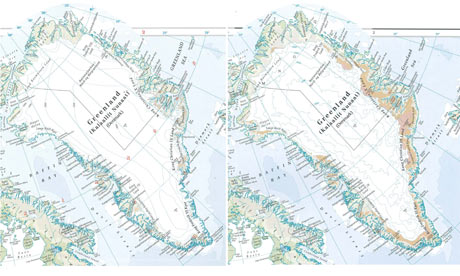So continuing from the last post, what did you think about the video? For me, I was trying to see the start and ends of each seasons. Summer of 2010 was pretty obvious, the extent of ice had retreated so much that most of the Arctic Circle was free of ice. And in the last few seconds of the video, we went back to winter where it seems to me that the ice had regained most, if not all, of the extent in '09. Now, just as a reminder, the Arctic Ocean, unlike the Antarctica, is composed mainly of sea ice.
Just by looking at this video, I would actually feel reassured since the ice extent seems to be recovering pretty well compared to '09. But of course, using a comparison that's only a year apart, when the Earth's history is about 4.5 billion years doesn't make sense. So for me, in this respect, the video fails to show any sort of significance (but is still very cool to watch).
Did you also notice that as the seasons passed, there were patches in the sea ice that seemed to be slightly bluer than the surrounding? Not because it's free of ice but rather the ice is thinner at those places. Like the Antarctic, the thickness of the sea ice is important as an indicator of ocean temperature. The Arctic Ocean plays the same role as the Antarctic for the Northern Hemisphere. It's a thermometer of climate change. However, the Arctic Ocean may be slightly more vulnerable than the Antarctic since its extent is directly dependent on the ocean temperature. Huge bodies of water have higher heat capacities and stay warmer for longer and this has implications on the sea ice thickness, extent and rate of recovery as it progresses from summer to winter. But this discussion of the interaction of the sea ice and the ocean dynamics shall have to be saved for another time.
I was exploring the NASA image gallery of the Arctic Ocean when I came across this article titled 'Ponds on the Ocean'. In the previous paragraph, I mentioned that there were patches of 'discolourations' on the Arctic Ocean where in some parts, the ice was thinner than the surroundings. This article explains them very well. These ponds are formed during the spring and summer melt. So if you remember primary school science well, when ice forms, it leaves behind most of its salts. When parts of the surfaces of the ice melts, they then form freshwater ponds on top of the salty ocean water. That is very cool. You won't find that anywhere else in the world!
Then, what is the point of me telling you all these things? Yes, the ice is thinning but aren't we doing things now to prevent more destructive climate changes from occurring to the best of our abilities (or so we believe)?
I think we should remember that on the Arctic Ocean, there's a huge ecosystem that's highly vulnerable to these changes. Ice thinning means that cracks occur more frequently, quicker and larger than before. And they occur most during spring and summer when temperatures are above melting point. And animals come out to hunt then in preparation for the winter. And unlike humans, they do not have the benefit of technology to overcome these adversities that are hitting them fast and hard. Polar bear populations are dropping and the increasing difficulty in hunting isn't making their lives any easier. Arctic wolves, birds, Eskimos or Inuits (whichever you feel is more politically correct) are having to adapt their way of lives and hunting behaviour to these changes in the ice in the Arctic Circle.
The question then we have to think about is whether or not they can adapt to these changes fast enough. The popular example of the polar bears shows that they can't. Should we then abandon trying to save them? We're living in the Holocene (or the Anthropocene), the climate will only get warmer since we're in the inter-glacial period. Living things that cannot adapt to the warming will only then become extinct as is the workings of Nature. Let's have a good think about this.



